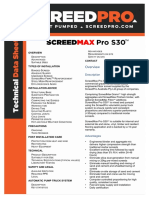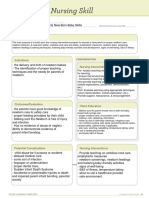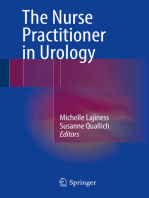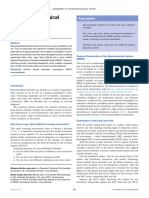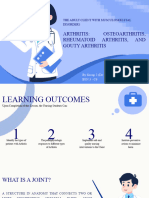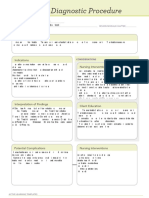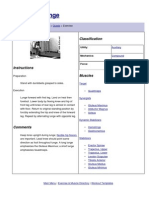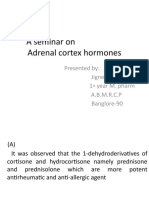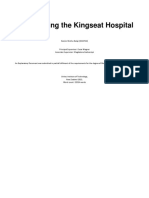Waiters Osteoarthritis PDF
Waiters Osteoarthritis PDF
Uploaded by
TommieCopyright:
Available Formats
Waiters Osteoarthritis PDF
Waiters Osteoarthritis PDF
Uploaded by
TommieOriginal Title
Copyright
Available Formats
Share this document
Did you find this document useful?
Is this content inappropriate?
Copyright:
Available Formats
Waiters Osteoarthritis PDF
Waiters Osteoarthritis PDF
Uploaded by
TommieCopyright:
Available Formats
ACTIVE LEARNING TEMPLATE: System Disorder
Tommie A Waiters
STUDENT NAME______________________________________
Osteoarthritis
DISORDER/DISEASE PROCESS___________________________________________________________ REVIEW MODULE CHAPTER____________
Alterations in Pathophysiology Related Health Promotion and
Health (Diagnosis) to Client Problem Disease Prevention
Degenerative joint disease (DJD), a It is a noninflammatory - Maintain healthy weight to decrease joint
degeneration of the hips and knees
disorder characterized by progressive
deterioration of the articular cartilage (unless localized), - avoid or limit repetitive strain on joints-well fitting shoes
nonsystemic disease
ASSESSMENT SAFETY
CONSIDERATIONS
Risk Factors Expected Findings If pt has walker:
- joint pain and stiffness- pain with join palpitations or ROM
- adults over 60 - genetic factors - crepitus (grating sound caused by the rubbing of bone fragments) remove rugs, tape
- joint injury due to acute or repetitive stress - enlarged joint related to bone hypertrophy- Heberden’s nodes
cords to
enlarged at distal interphalangeal joints- Bouchard’s nodes located
on joints predisposes to later OA at the proximal interphalangeal joints (OA is not a symmetrical dx, but
- obesity (knees- weight bearing joint) these nodes can occur bilaterally) can be inflamed and painful baseboards, etc
- metabolic dx (DM,SCD) avoid falls and trips
monitor
medication input
Laboratory Tests Diagnostic Procedures
- X-rays: show worn-down cartilage of joints
- magnetic resonance imaging with or without contrast
- usually normal erythrocyte sedimentation rate - CT scans
- high-sensitivity C-reactive protein can be - nuclear bone scan
- CT myelogram
increased related to secondary synovitis - EMG and nerve conduction
- arthrogram
PATIENT-CENTERED CARE Complications
Nursing Care Medications Client Education - Fat Embolism
teach about incentive spirometry, transfusion,
Venous
- Pain Assessment and Monitoring - Analgesic: does
- - Musculoskeletal not provide
surgical drains, dressing, pain control, transfer,
exercises, and activity limits
-Thromboembolis
Assessment/Muscle Tone and anti-inflammatory
teach about autologous blood donation
m
Strength- Neurological benefits - Osteomyelitis
Assessment/Sensory Perception
- - Psychosocial Assessment:
- *NSAIDS - Avascular
- Corticosteroid Necrosis
injections
- Trolamine
- Doesn't Heal
- Physiotherapist
Therapeutic Procedures salicylate Interprofessional Care
- Lidocaine 5% RD:
- Chiropractic/spinal patch: use for 12 nurse, dietician interprofessional
manipulation hr daily physiotherapist, or MSK team
- Glucosamine supplement - Capsaicin: must
- Intra-articular injections: wear nitrile gloves
kinesiologist, Occupational
glucocorticoids, hyaluronic acid Therapist
ACTIVE LEARNING TEMPLATES
You might also like
- ScreedMax Pro S30 TDS and MSDS PDFDocument16 pagesScreedMax Pro S30 TDS and MSDS PDFfuaunNo ratings yet
- Waiters Teaching New Parents PDFDocument1 pageWaiters Teaching New Parents PDFTommieNo ratings yet
- Nursing Care Plan - Posterior Hip Dislocation LeftDocument1 pageNursing Care Plan - Posterior Hip Dislocation LeftJasmin Jacob100% (7)
- The Intersubjective Perspective by Robert D Stolorow, George E. Atwood, Bernard BrandchaftDocument233 pagesThe Intersubjective Perspective by Robert D Stolorow, George E. Atwood, Bernard BrandchaftAmbrose66No ratings yet
- The Antidote to Suffering: How Compassionate Connected Care Can Improve Safety, Quality, and ExperienceFrom EverandThe Antidote to Suffering: How Compassionate Connected Care Can Improve Safety, Quality, and ExperienceNo ratings yet
- The Ethic of Care: A Moral Compass for Canadian Nursing Practice - Revised EditionFrom EverandThe Ethic of Care: A Moral Compass for Canadian Nursing Practice - Revised EditionNo ratings yet
- 16 STENSRUD A 12 Week Exercise Therapy Program in Middle Aged PatientsDocument13 pages16 STENSRUD A 12 Week Exercise Therapy Program in Middle Aged PatientsLuis MiguelNo ratings yet
- Waiters Postpartal Hemorrhage PDFDocument1 pageWaiters Postpartal Hemorrhage PDFTommieNo ratings yet
- Outpatient Introductory Training PacketDocument8 pagesOutpatient Introductory Training PacketJagr MaddoxNo ratings yet
- Controlled Substance Ordering System A Complete Guide - 2021 EditionFrom EverandControlled Substance Ordering System A Complete Guide - 2021 EditionNo ratings yet
- Transition to the Registered Professional Nurse Role: Passbooks Study GuideFrom EverandTransition to the Registered Professional Nurse Role: Passbooks Study GuideNo ratings yet
- Textbook of Urgent Care Management: Chapter 34, Engaging Accountable Care Organizations in Urgent Care CentersFrom EverandTextbook of Urgent Care Management: Chapter 34, Engaging Accountable Care Organizations in Urgent Care CentersNo ratings yet
- Nursing care process in patients with chronic obstructive pulmonary diseaseFrom EverandNursing care process in patients with chronic obstructive pulmonary diseaseNo ratings yet
- The Nurse Practitioner in UrologyFrom EverandThe Nurse Practitioner in UrologyMichelle LajinessNo ratings yet
- COMPREHENSIVE NURSING ACHIEVEMENT TEST (RN): Passbooks Study GuideFrom EverandCOMPREHENSIVE NURSING ACHIEVEMENT TEST (RN): Passbooks Study GuideNo ratings yet
- Heart, Functions, Diseases, A Simple Guide To The Condition, Diagnosis, Treatment And Related ConditionsFrom EverandHeart, Functions, Diseases, A Simple Guide To The Condition, Diagnosis, Treatment And Related ConditionsNo ratings yet
- Critical Care for Anorexia Nervosa: The MARSIPAN Guidelines in PracticeFrom EverandCritical Care for Anorexia Nervosa: The MARSIPAN Guidelines in PracticeNo ratings yet
- Ebstein Anomaly, A Simple Guide To The Condition, Diagnosis, Treatment And Related ConditionsFrom EverandEbstein Anomaly, A Simple Guide To The Condition, Diagnosis, Treatment And Related ConditionsNo ratings yet
- Pocket Book for Simulation Debriefing in HealthcareFrom EverandPocket Book for Simulation Debriefing in HealthcareRating: 5 out of 5 stars5/5 (1)
- A Caring Advanced Practice Nursing Model: Theoretical Perspectives And Competency DomainsFrom EverandA Caring Advanced Practice Nursing Model: Theoretical Perspectives And Competency DomainsNo ratings yet
- Intubating the Critically Ill Patient: A Step-by-Step Guide for Success in the ED and ICUFrom EverandIntubating the Critically Ill Patient: A Step-by-Step Guide for Success in the ED and ICURachel GarvinNo ratings yet
- Community Health A Complete Guide - 2020 EditionFrom EverandCommunity Health A Complete Guide - 2020 EditionRating: 5 out of 5 stars5/5 (1)
- Triage: A History of America's Frontline Medics from Concord to Covid-19From EverandTriage: A History of America's Frontline Medics from Concord to Covid-19No ratings yet
- Joint Pain One PagerDocument3 pagesJoint Pain One PagermustafaNo ratings yet
- OsteoarthritisDocument2 pagesOsteoarthritisapi-518311936No ratings yet
- The Rheumatological ExaminationDocument5 pagesThe Rheumatological ExaminationRobles Murillo Carlos Eduardo Augusto 1FNo ratings yet
- Imaging in Football Medicine: Perennial FavouritesDocument11 pagesImaging in Football Medicine: Perennial FavouritesTeuku Ona AriefNo ratings yet
- ClaudicationDocument2 pagesClaudicationvfsqp9zxgqNo ratings yet
- OSTEOARTHRITISDocument5 pagesOSTEOARTHRITISMauren DazaNo ratings yet
- Arthritis Oa Ra GaDocument49 pagesArthritis Oa Ra GaKezia Keren Dela CruzNo ratings yet
- High Velocity Manipulation TechniquesDocument2 pagesHigh Velocity Manipulation TechniquesBhargavaNo ratings yet
- ACC GP MRI Service HandbookDocument22 pagesACC GP MRI Service HandbookBruno Souza Braga100% (1)
- Day 7 - KIN 4200 - 2024 - Corrective Exercise - Inhibition and LengtheningDocument25 pagesDay 7 - KIN 4200 - 2024 - Corrective Exercise - Inhibition and Lengtheningavocado 677No ratings yet
- Pedia RheumatologyDocument13 pagesPedia RheumatologyJuda Zhēn ZhūNo ratings yet
- ACC GP MRI Service HandbookDocument22 pagesACC GP MRI Service HandbookIzzeldin ZakiNo ratings yet
- Assessment of Musculo-Skeletal System: 2 Year B. SC NursingDocument33 pagesAssessment of Musculo-Skeletal System: 2 Year B. SC NursingRubin100% (1)
- Assessment MusculoskeletalDocument33 pagesAssessment MusculoskeletalRubinNo ratings yet
- Review Article Kel 4Document10 pagesReview Article Kel 4AyuNo ratings yet
- Adductor Strains in AthletesDocument5 pagesAdductor Strains in Athletesdanieldiaz11jrNo ratings yet
- Comprehensive SummaryDocument37 pagesComprehensive Summaryhrg79qzwc2No ratings yet
- Waiters Pulmonary Function Test PDFDocument1 pageWaiters Pulmonary Function Test PDFTommie0% (1)
- Waiters Morphine PDFDocument2 pagesWaiters Morphine PDFTommieNo ratings yet
- Waiters Pulmonary Embolism Form PDFDocument1 pageWaiters Pulmonary Embolism Form PDFTommie0% (1)
- Waiters Rheumatoid Arthritis PDFDocument1 pageWaiters Rheumatoid Arthritis PDFTommie100% (1)
- Waiters Nonstress Test PDFDocument1 pageWaiters Nonstress Test PDFTommieNo ratings yet
- Hope College of Arts & Sciences: Program of Study PlanDocument2 pagesHope College of Arts & Sciences: Program of Study PlanTommieNo ratings yet
- Waiters Salmeterol PDFDocument1 pageWaiters Salmeterol PDFTommieNo ratings yet
- Waiters-PneumoniaSystem Disorder Form PDFDocument1 pageWaiters-PneumoniaSystem Disorder Form PDFTommieNo ratings yet
- Waiters Rhabdomyolysis PDFDocument1 pageWaiters Rhabdomyolysis PDFTommieNo ratings yet
- Waiters Tommie Alajandro 1757 1068397665 Awp PDFDocument771 pagesWaiters Tommie Alajandro 1757 1068397665 Awp PDFTommieNo ratings yet
- Waiters Newborn Care PDFDocument1 pageWaiters Newborn Care PDFTommieNo ratings yet
- Waiters Remdesivir - Drug - CardDocument6 pagesWaiters Remdesivir - Drug - CardTommieNo ratings yet
- Waiters Uterine Curette PDFDocument1 pageWaiters Uterine Curette PDFTommieNo ratings yet
- Waiters. Eng 101Document3 pagesWaiters. Eng 101TommieNo ratings yet
- Waiters Proning PDFDocument1 pageWaiters Proning PDFTommieNo ratings yet
- Waiters PATIENT CARE PLAN 2020 For PPHDocument3 pagesWaiters PATIENT CARE PLAN 2020 For PPHTommieNo ratings yet
- Waiters, Tommie POS Spring 2019 PDFDocument2 pagesWaiters, Tommie POS Spring 2019 PDFTommieNo ratings yet
- 326 Mental - Status - Examination Directions and RubricDocument4 pages326 Mental - Status - Examination Directions and RubricTommieNo ratings yet
- Pneumonia Nursing Care Plans: Short Term: Short Term: After 3-4Document2 pagesPneumonia Nursing Care Plans: Short Term: Short Term: After 3-4esteffie21No ratings yet
- The Nursing Process in Psychiatric/Mental Health NursingDocument30 pagesThe Nursing Process in Psychiatric/Mental Health NursingTommie0% (1)
- 20 List Office SuppliesDocument2 pages20 List Office SuppliesTommieNo ratings yet
- DB LungeDocument1 pageDB LungeRAM NAIDU CHOPPANo ratings yet
- SC SLP FINAL Oct. 2012 Mamata BanerjeeDocument38 pagesSC SLP FINAL Oct. 2012 Mamata BanerjeeDeep HiraniNo ratings yet
- Aggressive Behaviors - ExtendedDocument7 pagesAggressive Behaviors - ExtendedTeresa Silva100% (1)
- QACPS Calendar Handbook 2015-2016Document50 pagesQACPS Calendar Handbook 2015-2016Tyler J StitcherNo ratings yet
- New Manager Self Test - Page 132: Chapters 5 & 6 Session 3 AssignmentDocument9 pagesNew Manager Self Test - Page 132: Chapters 5 & 6 Session 3 AssignmentJessica FrickNo ratings yet
- Nutrients 14 01255 With CoverDocument18 pagesNutrients 14 01255 With CoverLuis ricardo Véjar felixNo ratings yet
- Pe 1 Final ModuleDocument10 pagesPe 1 Final Modulealexa dawatNo ratings yet
- War Surgery - Working With Limited ResourcesDocument357 pagesWar Surgery - Working With Limited ResourcesMichael Yoder100% (1)
- Fabrication of Low Cost Mechanical Ventilator With Patient MonitoringDocument8 pagesFabrication of Low Cost Mechanical Ventilator With Patient MonitoringNagesh NNo ratings yet
- Brand AwarenessDocument8 pagesBrand AwarenessSonia KumariNo ratings yet
- Critical Consioucness 3Document6 pagesCritical Consioucness 3Praise NehumambiNo ratings yet
- Job Satisfaction and Withdrawal BehaviorDocument8 pagesJob Satisfaction and Withdrawal BehaviorI IvaNo ratings yet
- Pangasinan State University Sta. Maria Campus Sta. Maria, PangasinanDocument8 pagesPangasinan State University Sta. Maria Campus Sta. Maria, PangasinanPrince Aira BellNo ratings yet
- Corn PresentationDocument20 pagesCorn PresentationPooja ShrivastavNo ratings yet
- Analisa Jurnal PneumoniaDocument14 pagesAnalisa Jurnal PneumoniaSindy OctaNo ratings yet
- Business Plan Stem 11 HospitalDocument7 pagesBusiness Plan Stem 11 HospitalClarisse Biagtan CerameNo ratings yet
- B7 C. TECH T1-1.docx 2 (2) TTDocument35 pagesB7 C. TECH T1-1.docx 2 (2) TTweijapresbyNo ratings yet
- Methodological Issues in Patient Satisfaction SurveyDocument6 pagesMethodological Issues in Patient Satisfaction SurveyLim LeePingNo ratings yet
- The Power of Art A Journey Through Creativity Expression and InspirationDocument2 pagesThe Power of Art A Journey Through Creativity Expression and Inspirationradin alifiNo ratings yet
- A Seminar On Adrenal Cortex Hormones: Presented By: Jignesh Patel 1 Year M. Pharm A.B.M.R.C.P Banglore-90Document14 pagesA Seminar On Adrenal Cortex Hormones: Presented By: Jignesh Patel 1 Year M. Pharm A.B.M.R.C.P Banglore-90Amit GhoshNo ratings yet
- Assefa Research Proposal 2013Document50 pagesAssefa Research Proposal 2013tsegaw kebede92% (12)
- Food Psychology PresentationDocument14 pagesFood Psychology PresentationHafsa JahanNo ratings yet
- File 319Document88 pagesFile 319Crypto DocNo ratings yet
- Adaptive Reuse of Kingseat HospitalDocument160 pagesAdaptive Reuse of Kingseat HospitalbalajiNo ratings yet
- How To Make A Literature Review TableDocument8 pagesHow To Make A Literature Review Tabletwfmadsif100% (1)
- Oee & OsasDocument13 pagesOee & OsasVaibhav Eknathrao TandaleNo ratings yet
